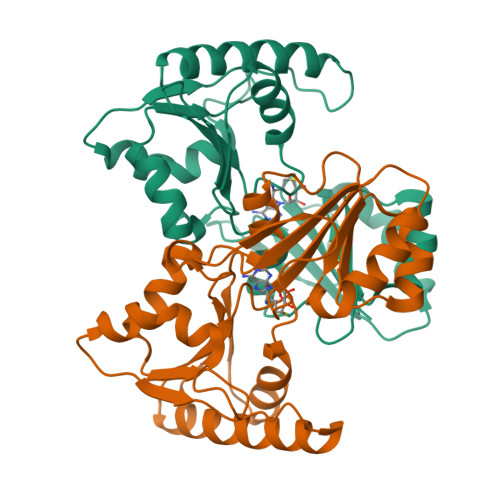Elucidation of substrate specificity in the cobalamin (vitamin B12) biosynthetic methyltransferases. Structure and function of the C20 methyltransferase (CbiL) from Methanothermobacter thermautotrophicus.
Frank, S., Deery, E., Brindley, A.A., Leech, H.K., Lawrence, A., Heathcote, P., Schubert, H.L., Brocklehurst, K., Rigby, S.E., Warren, M.J., Pickersgill, R.W.(2007) J Biological Chem 282: 23957-23969
- PubMed: 17567575
- DOI: https://doi.org/10.1074/jbc.M703827200
- Primary Citation of Related Structures:
2QBU - PubMed Abstract:
Ring contraction during cobalamin (vitamin B12) biosynthesis requires a seemingly futile methylation of the C20 position of the tetrapyrrole framework. Along the anaerobic route, this reaction is catalyzed by CbiL, which transfers a methyl group from S-adenosyl-L-methionine to cobalt factor II to generate cobalt factor III. CbiL belongs to the class III methyltransferases and displays similarity to other cobalamin biosynthetic methyltransferases that are responsible for the regiospecific methylation of a number of positions on the tetrapyrrole molecular canvas. In an attempt to understand how CbiL selectively methylates the C20 position, a detailed structure function analysis of the enzyme has been undertaken. In this paper, we demonstrate that the enzyme methylates the C20 position, that its preferred substrate is cobalt factor II, and that the metal ion does not undergo any oxidation change during the course of the reaction. The enzyme was crystallized, and its structure was determined by x-ray crystallography, revealing that the 26-kDa protein has a similar overall topology to other class III enzymes. This helped in the identification of some key amino acid residues (Asp(104), Lys(176), and Tyr(220)). Analysis of mutant variants of these groups has allowed us to suggest potential roles that these side chains may play in substrate binding and catalysis. EPR analysis of binary and ternary complexes indicate that the protein donates a fifth ligand to the cobalt ion via a gated mechanism to prevent transfer of the methyl group to water. The chemical logic underpinning the methylation is discussed.
Organizational Affiliation:
Protein Science Group, Department of Biosciences, University of Kent, Canterbury, Kent, CT2 7NJ, United Kingdom.

















